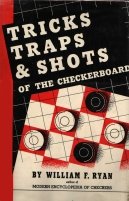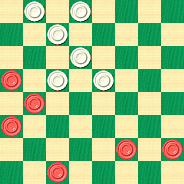The Checker Maven
Jump to navigationSemple's Eye Opener

Today's entry in our ongoing series of reprints from Willie Ryan's classic Tricks Traps & Shots of the Checkerboard is indeed an eye-opener. It's one of the very few examples in the book that appears to be based a flawed premise. It happens to the best of them, and Willie didn't have a dual-core 2.4GHz computer with 4GB of memory and a 220MB 10-piece endgame database at his disposal. So we might allow him to miss one now and then. The truth is that he didn't miss very many.
We're showing the problem in its original representation, then we're showing the computer alternative and asking you to correct Willie's play! That's asking a lot, but this is a challenging example and well worth your time. We have no doubt you'll be referring to your own computer program before you're done, and if you find anything new or anything that needs further correction, please send it to us at editor@checkermaven.com.
Now, over to Willie.

"The old-timers haven't authored all the brillancies of the checkerboard by any means. The American players, in particular, have added many bright pages to the game's scientific lore in the last 40 years. At Martin's Ferry, Ohio, there resides a famous barber, Paul Semple by name, who has enriched checker literature by his many outstanding problem compositions. The artistic stroke recorded here is probably Professor Semple's finest contribution to the art of scientific play up to now, but we can expect more good things from him. The game leading up to Semple's shot is the work of Author Ryan, but the stroke itself was shown by Semple as a problem several years before a tenable game could be worked out to lead up to it.
| 11-16 | 25-18 | 6-22 |
| 21-17 | 5-9 | 30-26 |
| 9-13 | 26-22 | 22-25---5 |
| 23-18 | 8-11 | 29-22 |
| 7-11---1 | 15-8 | 11-16---6 |
| 18-15---2 | 4-11 | 26-23 |
| 11-18 | 28-24 | 2-6*---7 |
| 22-15 | 16-20---3 | 22-18---A, 8 |
| 10-19 | 22-17---4 | 1-5---11 |
| 24-15 | 9-14 | 24-19. |
| 13-22 | 18-9 | See the |
| diagram. |
A—If white plays 23-18, black effects a draw with: 6-10, 31-26---9 (32-28, 3-8*, 18-15, 10-19, 24-15, 1-6*, etc., a draw---10), 1-6*, 18-14, 10-17, 22-13, 3-7, 26-23; and clinches it with 7-11 or 7-10."
1---Inferior to 16-20 or 8-11---Ed.
2---25-21 is better---Ed..
3---6-10 is much better here---Ed.
4---24-19 would have held the lead. The game is now about even---Ed.
5---1-6 would have also been a natural drawing move---Ed.
6---1-6 is still good here as well---Ed.
7---We don't know why Willie stars this move, as it's an outright loss. 3-7 was the correct drawing move, although it took a deep computer search to demonstrate it clearly. After 2-6 one possible line of play is 23-18 6-9 18-15 1-6 15-11 9-13 11-8 3-7 24-19 16x23 27x18 7-11 8-3 11-16 18-14 16-19 3-8 19-23 8-11 23-26 22-17 13x22 14-10 6x15 11x25 White Wins. See also Notes 8 and 10 to Note A---Ed.
8---This move gives the draw back to Black. See Note 7 above for the winning White line with 23-18---Ed.
9---Willie goes wrong here; 32-28 retains the win.
10---We wish Willie didn't end with "etc." here as the game is lost for Black--- there is no draw. One line of play is 22-18 6-9 15-10 9-13 10-7 13-17 18-15 17-21 7-3 16-19 3-7 21-25 7-11 White Wins.
11---Another probable loss. 3-7 was the correct move to draw---Ed.
Willie leaves the position here as Black to draw, but based on computer analysis, we think it's actually a White win.

BLACK
Black to Play
B:W32,31,27,23,19,18:B20,16,12,6,5,3.
Here's the line of play that Willie proposes. We're asking you to take on the daunting task of correcting Willie's proposed play, and then finding the winning line for Black.
"Continue: 5-9*!, 19-15, 16-19*, 23-16, 12-19, 15-11, 19-24*!, 32-28---B, 9-14*!, 18-2, 3-7, 28-19, 7-32, ending in a draw. What a revelation!
B---If 11-8 is used, then the draw is established with: 3-12, 32-28, 9-13, 28-19, 13-17, 18-15, 17-22, 15-11, 22-25, 11-7, 25-30, 7-2, 6-9, 2-6, 9-13, 6-10, 30-25, or 13-17."
This won't be easy, and if you can do this without the aid of a computer, you're quite the player. But even if you don't solve it, trying to work it through will provide untold benefits. Besides, you can always click on Read More to see the eye-opening solution.![]()
Solution
19-15 is incorrect.
After 5-9, White should play 18-15 to win: 18-15 9-13 15-11 13-17 11-8 17-22 8-4 22-25 4-8 6-9 8-11 25-29 27-24 20x27 11x20 29-25 31x24 White Wins.
A real eye-opener indeed!

You can email the Webmaster with comments on this article.
